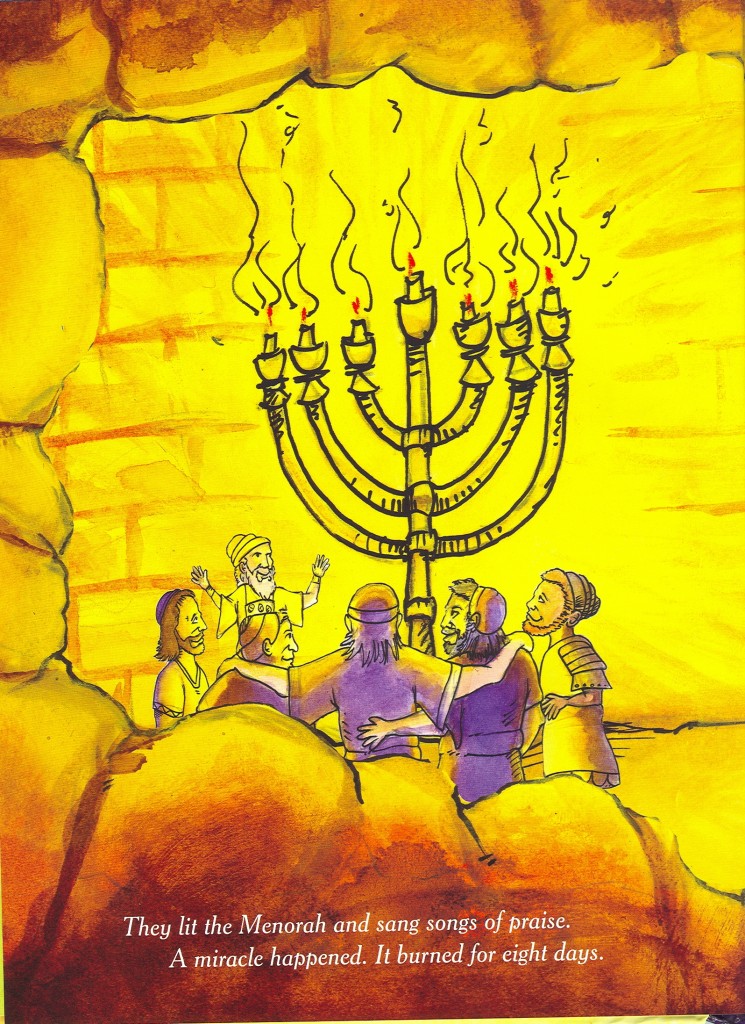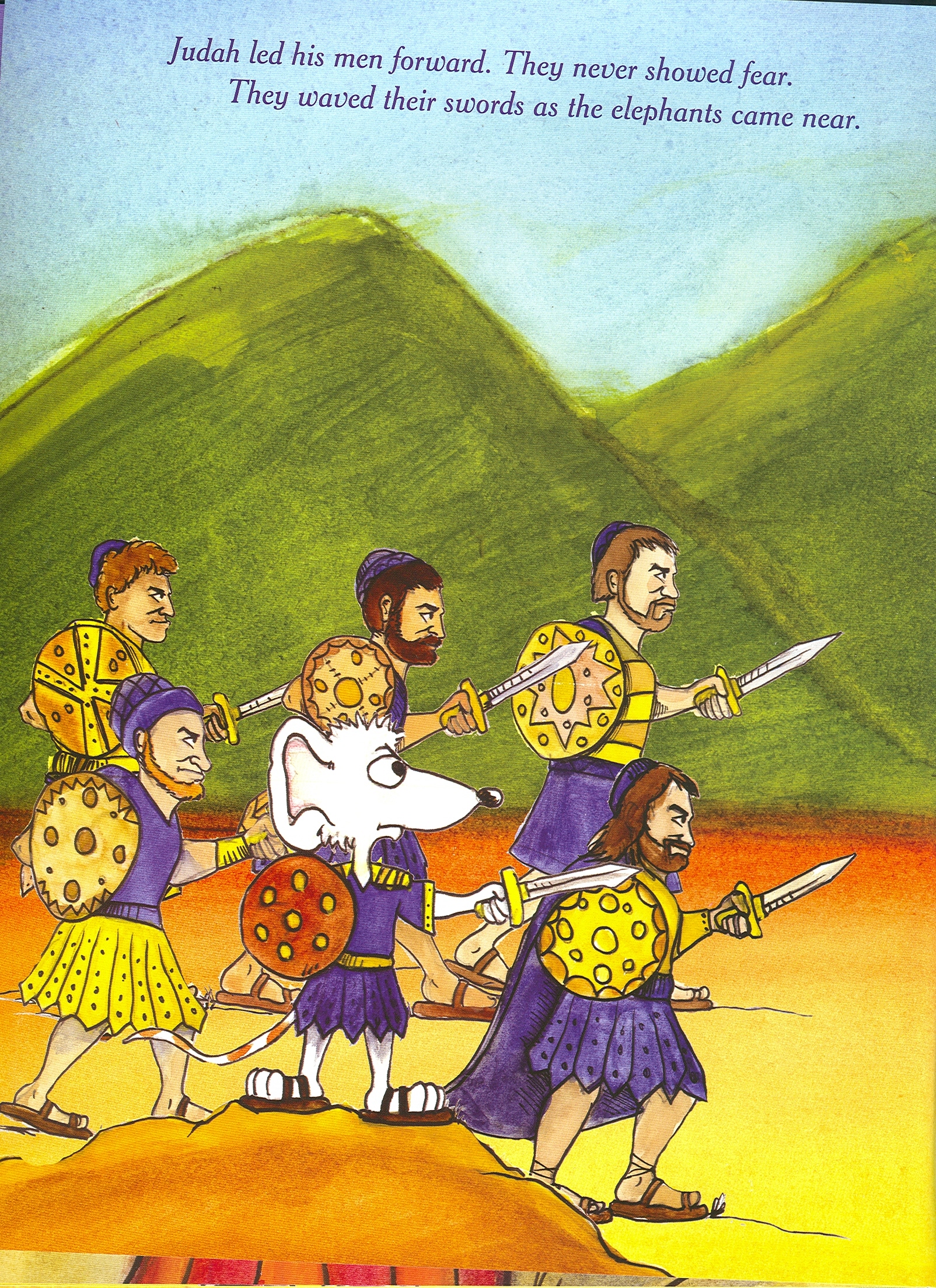Hanukkah: Background for parents, researched and written by Sylvia Rouss
Hanukkah is celebrated in the winter. It lasts for eight days and is also known as the Festival of Lights.
Hanukkah is based on a historical event and is a result of a conflict between the Jewish faith and Greek culture. Conquered by Alexander the Great, the Jewish people prospered and enjoyed religious freedom. In time, some Jews were influenced by the Greek ways and became increasingly Hellenized. With the death of Alexander, the Greek empire was divided between his generals into the empires of Egypt and Syria. The Jews lived in the Syrian-Greek Empire.
In the years that followed, Antiochus became the ruler of Syria. Under his rule, the Jews were forbidden to study Torah, observe Shabbat, and circumcise their male children. Idols were erected in the Jewish Temple in Jerusalem and pigs were sacrificed on its altar. Anyone who disobeyed Antiochus and his laws was killed.
Mattathias, an old priest, and his five sons led by Judah, opposed Antiochus. They gathered a small army and hid in the mountains, attacking Antiochus and his army at every opportunity. Because Judah was so strong, he became known as Judah Maccabee, the Hebrew word for hammer. The name was ultimately attributed to his entire army which managed to recapture Jerusalem and the Temple. The Temple was cleaned and rededicated.
A small amount of oil was found to light the seven-branch menorah that lit the Temple. There was only enough oil to burn for one day but miraculously, it burned for eight. As a result the Hanukkah menorah or Hanukkiyah has a place for nine lights—one for each of the eight days and a special light, the shamash that is used to light all the others. During Hanukkah, one more candle is lit each night until all the candles are lit on the eighth night.
At Hanukkah, special foods cooked in oil are eaten as a reminder of the miraculous oil. Potato pancakes called latkes are served as well as sufganiyot, jelly donuts, a tradition that comes from Israel.
A game using a four-sided top called a dreidle is played. It is similar to a game the ancient Jews played to fool the soldiers sent by Antiochus. Since it was forbidden to study Torah, the Jews would hide the Torah and pretend to be gambling with the dreidle. Today each side of the dreidle has a Hebrew letter which stands for the Hebrew words, “A great miracle happened there.” In Israel, the last letter is different and stands for “A great miracle happened here.”
Gift giving as well as the giving of Hanukkah gelt or Hanukkah money has become a part of the tradition. An additional treat for children, is chocolate Hanukkah gelt.
Vocabulary
- Hanukkah – Festival of lights
- Hanukkiyah – A nine branched menorah
- Shamash – the ninth candle on the Hanukkiyah which is on a separate level from the other candles and is used to light all the other candles
- Sufganiyot – jelly donut
- Dreidle – a four-sided top
- Gelt – money given at Hanukkah
Ways to Celebrate Hanukkah with Your Child
- Make Hanukkah decorations for your home.
- Fry latkes and invite family, friends and neighbors to share them.
- Play a CD of Hanukkah music.
- Read Hanukkah stories to your child.
- Sing Hanukkah songs with your child.
- Play the dreidle game: The dreidle has four sides with the Hebrew letters nun, gimmel, hay, shin on it. The letters stand for the words, “Nes gadol ha’ya sham” or a great miracle happened there. In Israel the letter shin has been replaced by a pay for the word po which means “here.”Players take turns spinning the dreidle. When the dreidle is twirled and falls with the letter nun facing up, each of the players puts a coin or candy in the “pot.” If the shin faces up, only the spinner puts a coin or candy in the pot. If the hay faces up, the spinner takes half the pot. If the gimmel faces up, the spinner takes all and the game begins again.
A RHYMING STORY OF HANUKKAH FOR YOUNG CHILDREN BY SYLVIA ROUSS
King Anticochus always wanted his way.
He told the Jews, “This is how you must pray!”
Judah Maccabee, a strong and brave Jew,
Said, “We won’t pray the way you want us to!”
He told King Antiochus, “You can’t stay.
The time has come for you to go away!”
The Temple was scrubbed from ceiling to floor.
The dirt was swept out the huge front door.
Then a small bit of oil was used to relight
The Temple Menorah, which lit up the night.
Let’s count the days that the oil burned, now.
Count on your fingers, I’ll show you how.
ONE, TWO, THREE, FOUR, FIVE, SIX, SEVEN, EIGHT!
NOW THAT’S A MIRACLE THAT’S REALLY GREAT!
“Intended for children between the ages of 3 and 6, “The Littlest Macabee” includes 24 wonderfully whimsical illustrations by Cohen who also created the cover art for this year’s High Holy Days supplement in the Jewish Review.The large-format storybook retells the events of Hanukkah chiefly from the perspective of an unnamed mouse whose uncommon courage in the face of the giant elephants used by the Greek soldiers helps to save the day for the Jews.” From the Jewish Review, Portland, Oregon, 12th of November 2011


